Reply 560 of 2152, by pshipkov
That sounds plausible for a 286@20.
That sounds plausible for a 286@20.
maxtherabbit wrote on 2021-09-09, 14:40:Never used a SCSI2SD before, but I'm getting 2677kB/s using DISKTEST in DOS on my 286-20 (10MHz ISA bus speed) with AHA-1542B connected to a 2GB 7200RPM Barracuda drive. DMA speed jumper set to 5.7 MB/s
I should have an old barracuda drive I can pull out and test. Hopefully it still spins.
Plan your life wisely, you'll be dead before you know it.
I tested an old Seagate magnetic drive and the speedsys buffered read result was 1627 KB/s, so the SCSI2SD is faster at 1935 KB/s. I then pulled out the AHA-1542CP and put in an AHA-1520B. The results with the 1520 and SCSI2SD were a lot better at 3502 KB/s. This is still far off from what I was expecting.
Why is the 1520B 80% faster than the 1542? I'm considering pulling the 1542 out of my AMI Mark V Baby Screamer with SXL2-66 and putting a 1522B in there. The 1542 is supposed to be the better because of DMA.
I then tried several PCI SCSI cards on the UUD, the 2940U2W, 2940W, 2940UW, and they all scored about 8700 KB/s.
Plan your life wisely, you'll be dead before you know it.
Looked at some of the Adaptec ISA SCSI controllers before. For reference.
Coretest is in agreement with SpeedSys on read speed, so the numbers are relevant to what you observe over there.
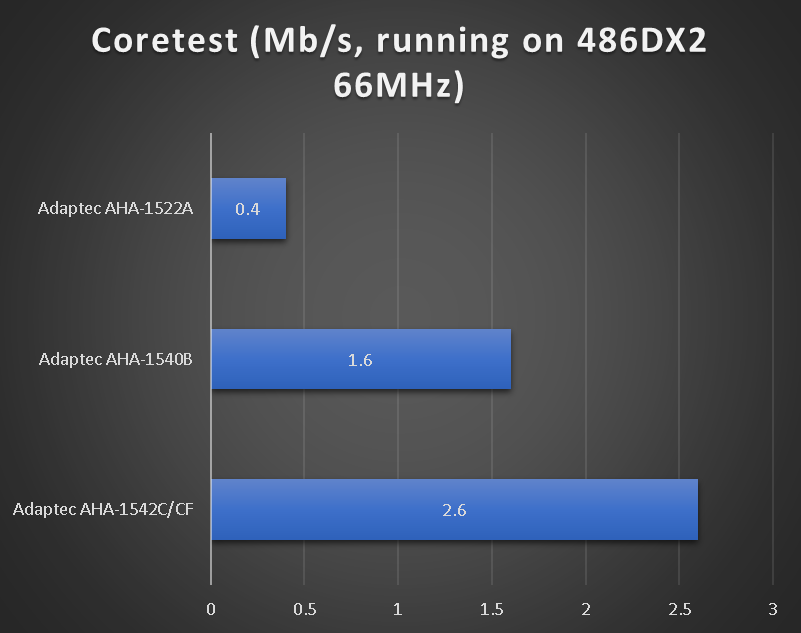
C was much faster than B - this i remember clearly.
Surprised that you are seeing B faster than C.
I don't see the 1520B or 1522B on that chart. Is the 1522A the same as the 1522B?
Plan your life wisely, you'll be dead before you know it.
Don't quote me but I think the 152x series all use the same ASIC
Don't have B versions here, sorry.
No idea about the silicon, but the 15xx versions differ in perf for sure.
Probably the final chapter of 486 at 180MHz - an exercise in practicality.
Why "probably" - about that at the end of the post.
From the bunch of inspected late 486 motherboards two stood out LuckyStar LS-486E rev:D and Biostar MB-8433uud-A revision 2.
After thorough examination of the two, LuckyStar was selected as a basis of what i think is the fastest long-term stable 486 PC around.
But reserve the right to change it to UUD at some point later - more about that at the end of the post.
So why LSD ?
This was discussed in previous post, also the links above provide clarity, but briefly:
Clock-to-clock faster than UUD.
Works well with Voodoo3, which seems to be a good match for late 486 system ticking at 180/200MHz.
Bonus point for compactness, since Voodoo3 and UUD don't play together and require VGA + Voodoo2.
So what goes in the PC:
AMD X3-133ADW @ 3.45V + Peltier active cooling
This particular CPU can do 180MHz in room temperatures pretty well, but is not fully stable.
The standard heatsink+fan is not enough, so Peltier thermal pump is inserted between processor/heatsink to normalize temperature range within 18-23C.
The lower the temperature the better, but if below ~18-20C - water condensation starts to build up. So, this enforces the lower boundary.
Fan size/speed, heatsink size/shape/material need to be balanced pretty well to ensure the right amount of heat is drained from the processor.
I mentioned this before but 2-3 out of 10 ADW/ADZ CPUs usually have healthy enough dies and can handle 180/200MHz.
Some require 4V at 180, some are ok with standard voltage.
All require 4V, or more for 200MHz.
So, overclocking past the 160MHz is actually easy. But doing it for a stable system is not trivial, as you can see below.
Initial design worked well on the open air test bench. Maintained the required 18-22C. Initial tests went well. Details here
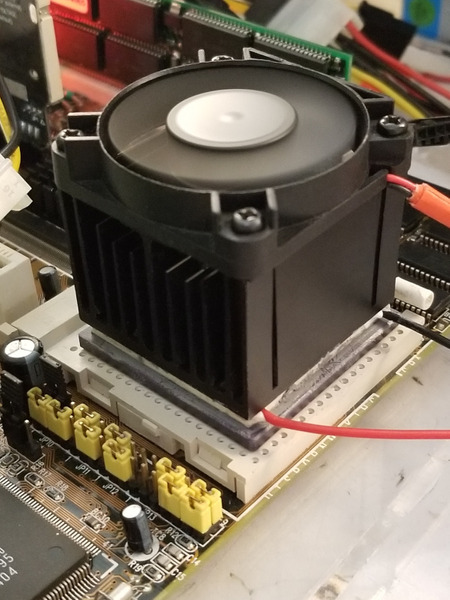
Completed design. Used a plastic piece that wraps the CPU. Its "teeth" hold the heatsink. Zip-ties add just enough pressure for the contraption to be very sturdy, yet easy to disassemble.
Unfortunately it failed when inside closed PC case. Other components increased the ambient temperature enough for the heatsink/fan to not be able to cool-down the Peltier thermal pump. CPU was overheating all the way to the 30-35C, which made it unstable at 180MHz.
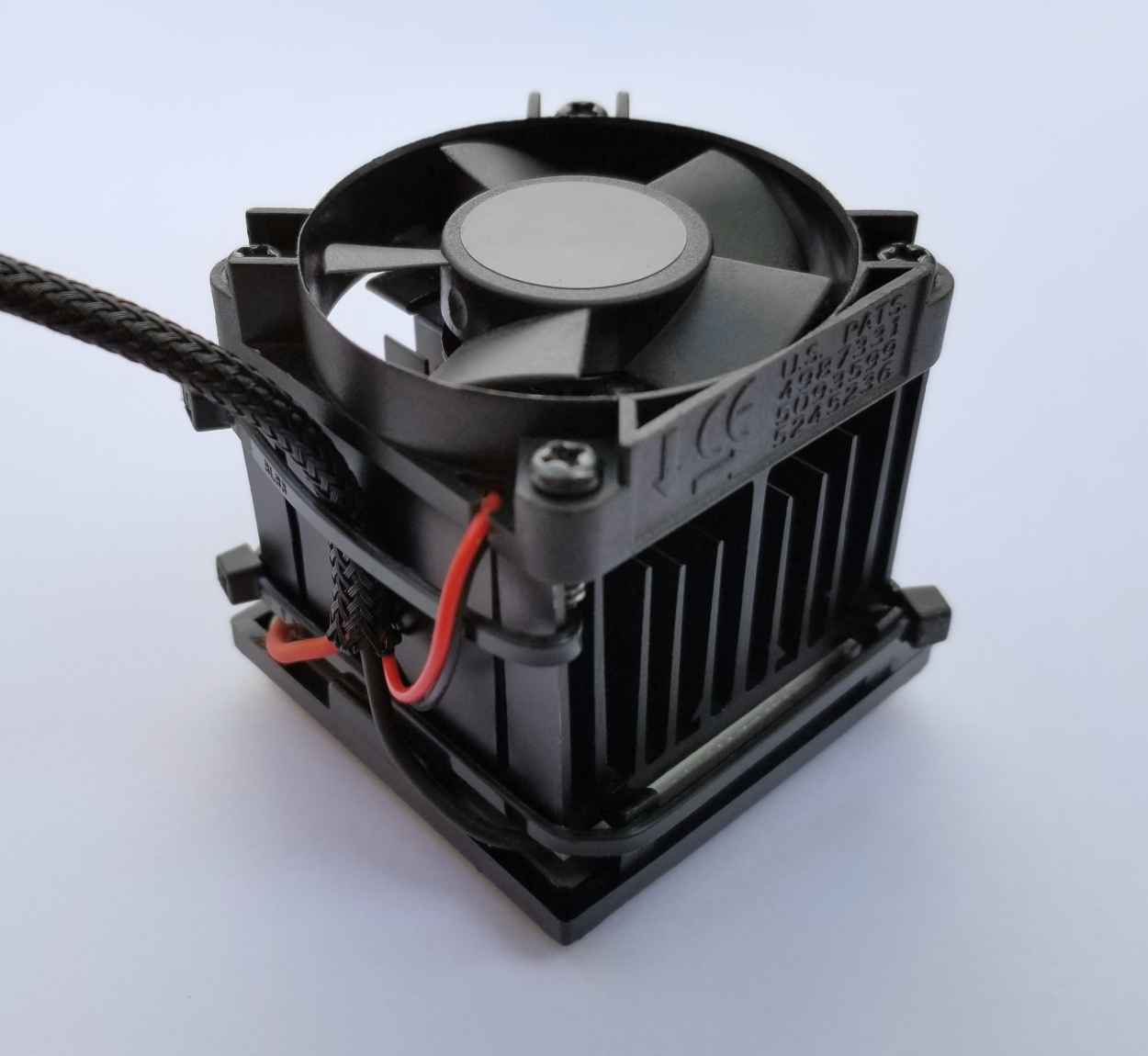
After quite a bit of experimentation with different components this is what i think worked well (for a while):
Keeps the CPU at 18-23C which is low-enough for stable 180MHz and high-enough to avoid water condensation.
12V to the fan, 12V to the Peltier.
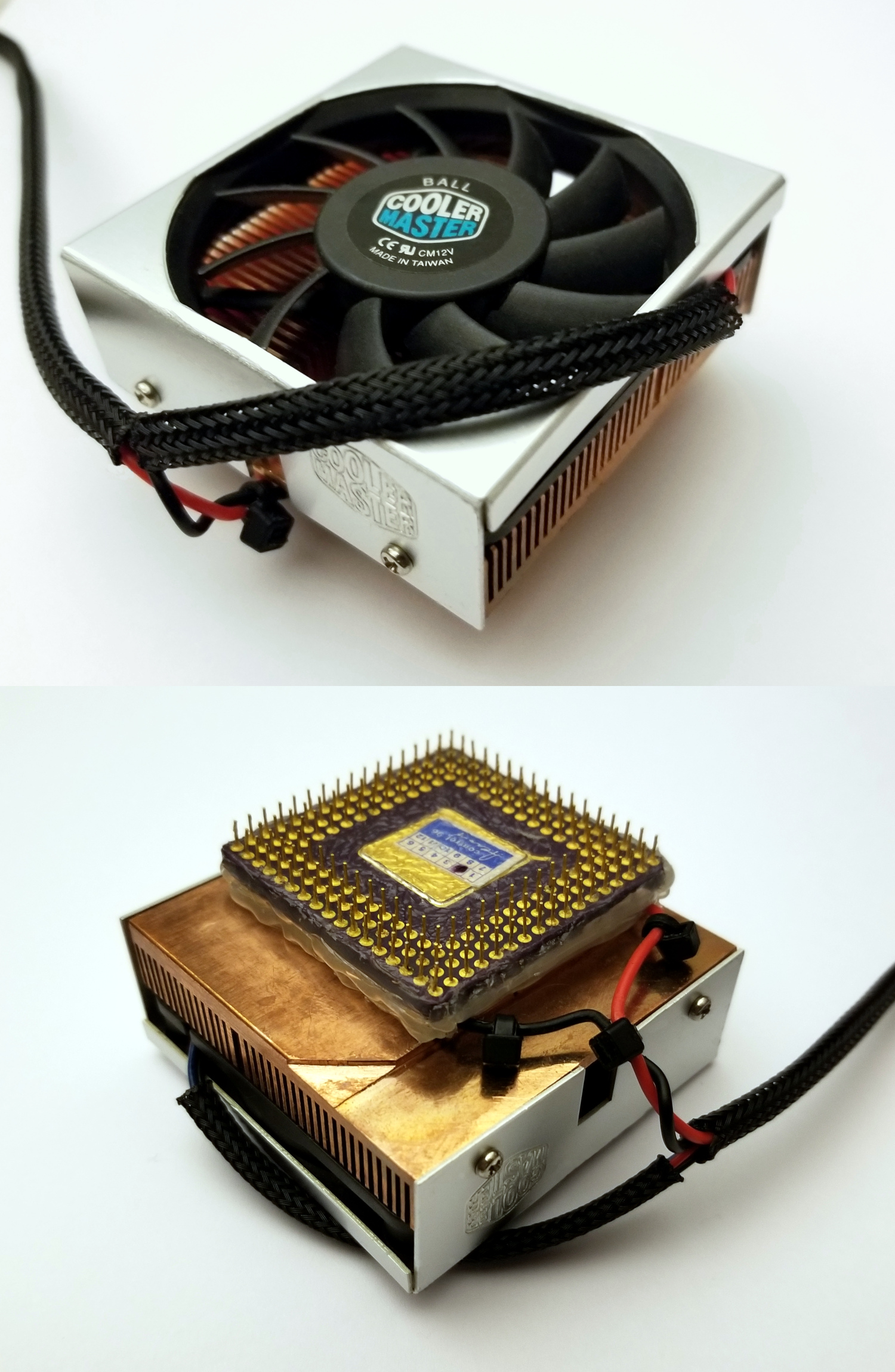
The above setup was overheating if ambient temperature was above ~25C.
After few more iterations arrived at something that appears to behave well.
5V to both Peltier and fan combined with bigger heatsink = less extreme electric and thermal conditions, yet maintains desired temperature range.
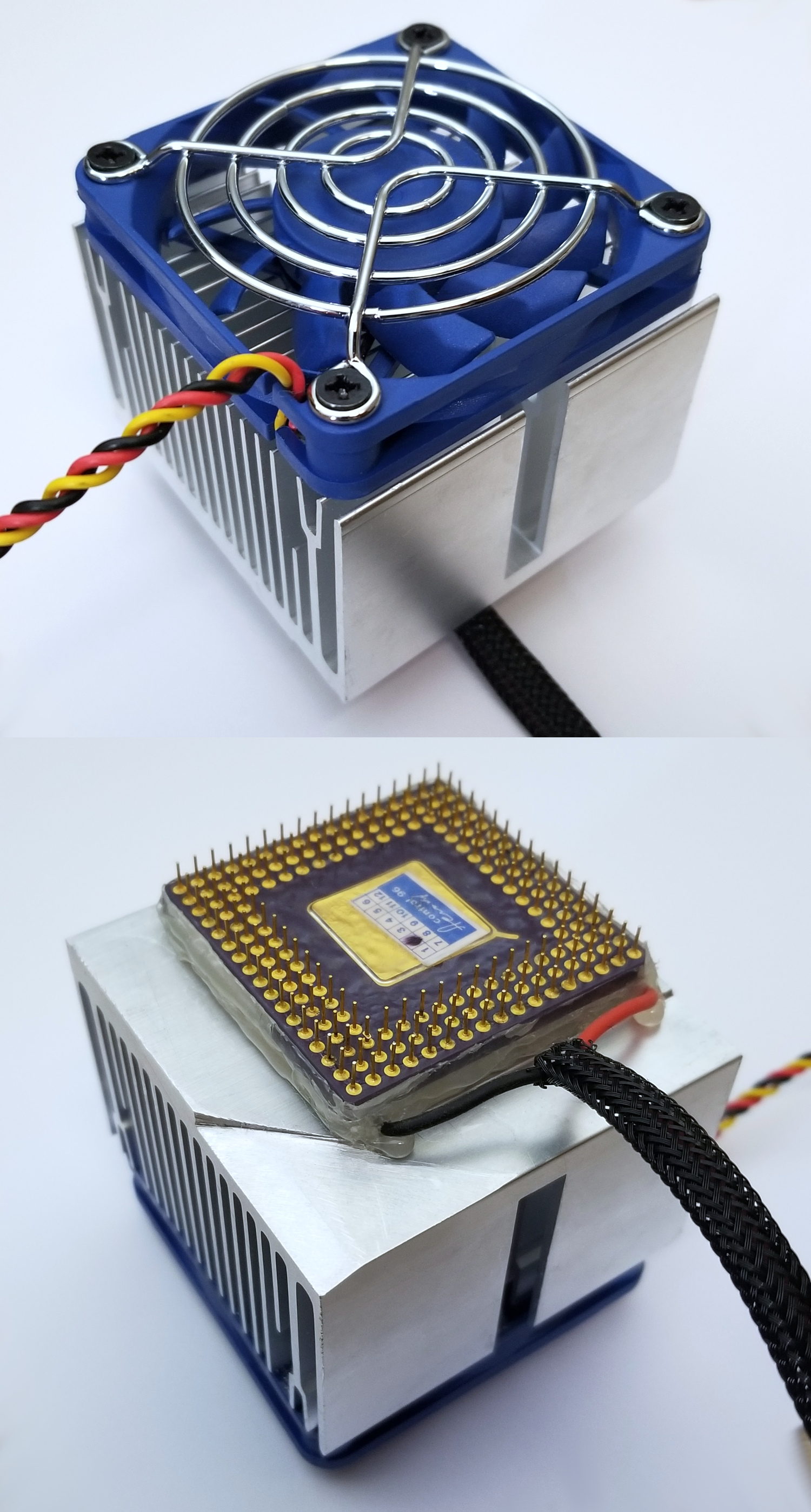
If the gap between upper side CPU, Peltier sides and bottom of heatsink is left untreated, then water condensation will eventually occur.
Initially contributed this to the temperature difference between CPU surface and ambient/air, but it is actually coming from the close proximity of hot/warm upper side Peltier + bottom heatsink and the cooler top/side CPU.
Filling that gap with silicon (some plastic really) prevents residual water condensation.
No condensation on the bottom of the CPU, but leaving there a layer of vaseline - just in case.
LuckyStar LS-486E rev:D with upgraded 15ns to 8ns L2 cache chips.
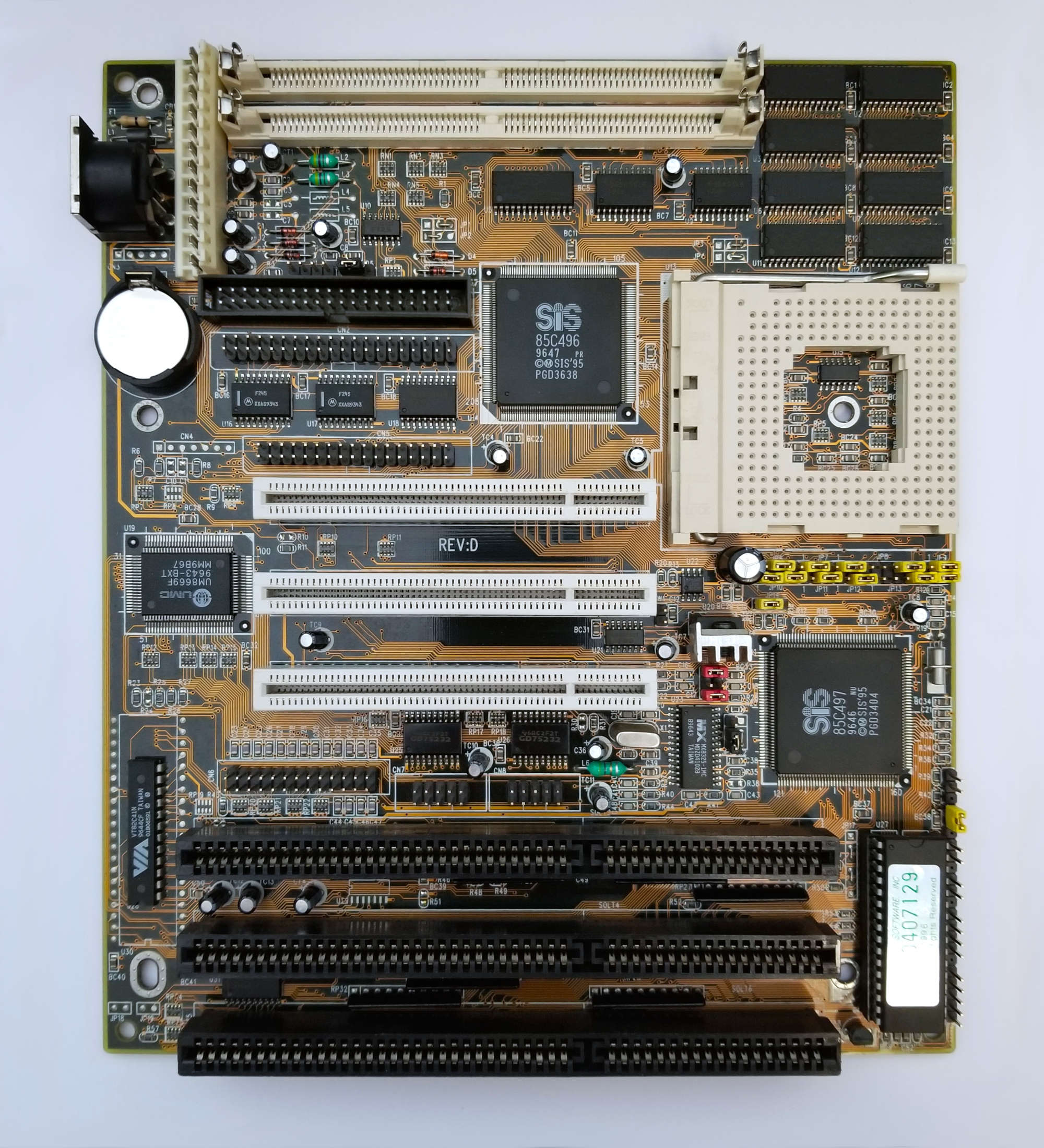
64Mb 50ns EDO system memory
Initially had 128Mb installed, but in Windows performance drops a bit when processes reach outside the cached range.
Going with 64Mb "only" for maximum performance. It is more than enough for this class hardware.
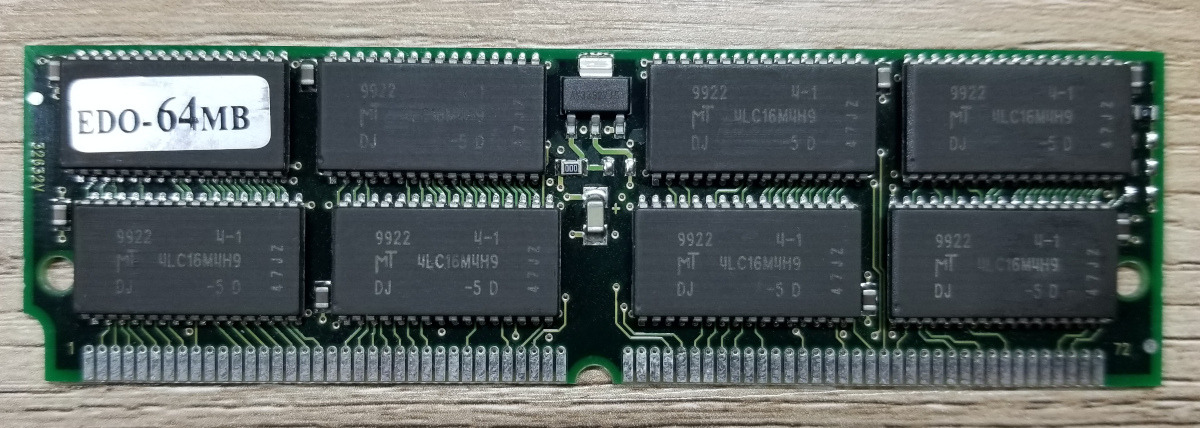
Voodoo3 2000. Came with the box. Now i keep inside Voodoo3 3000 (as a backup).
VGA core is on par with Matrox Millennium cards in DOS, much faster than them in Windows GUI, brings another dimension with accelerated 3D graphics - early 3D video game titles are border line playable on this rig.
The 2000 model can be overclocked to 190-200MHz when the system is running at 160MHz, but cannot go past 175-180MHz when system is in 180MHz (3x60) configuration. This brings it on par with the 3000 model.
Still, there is no point of overclocking the video card. 3D graphics are entirely CPU bound on this class hardware and there is no performance difference between the 2000 and 3000 V3 models.
Tried other 3D cards such as GeForce2 MX400 and 440, but they didn't work well, or at all.
400 fails at OpenGL - driver related issue. 440 does not light up at 180/200MHz.
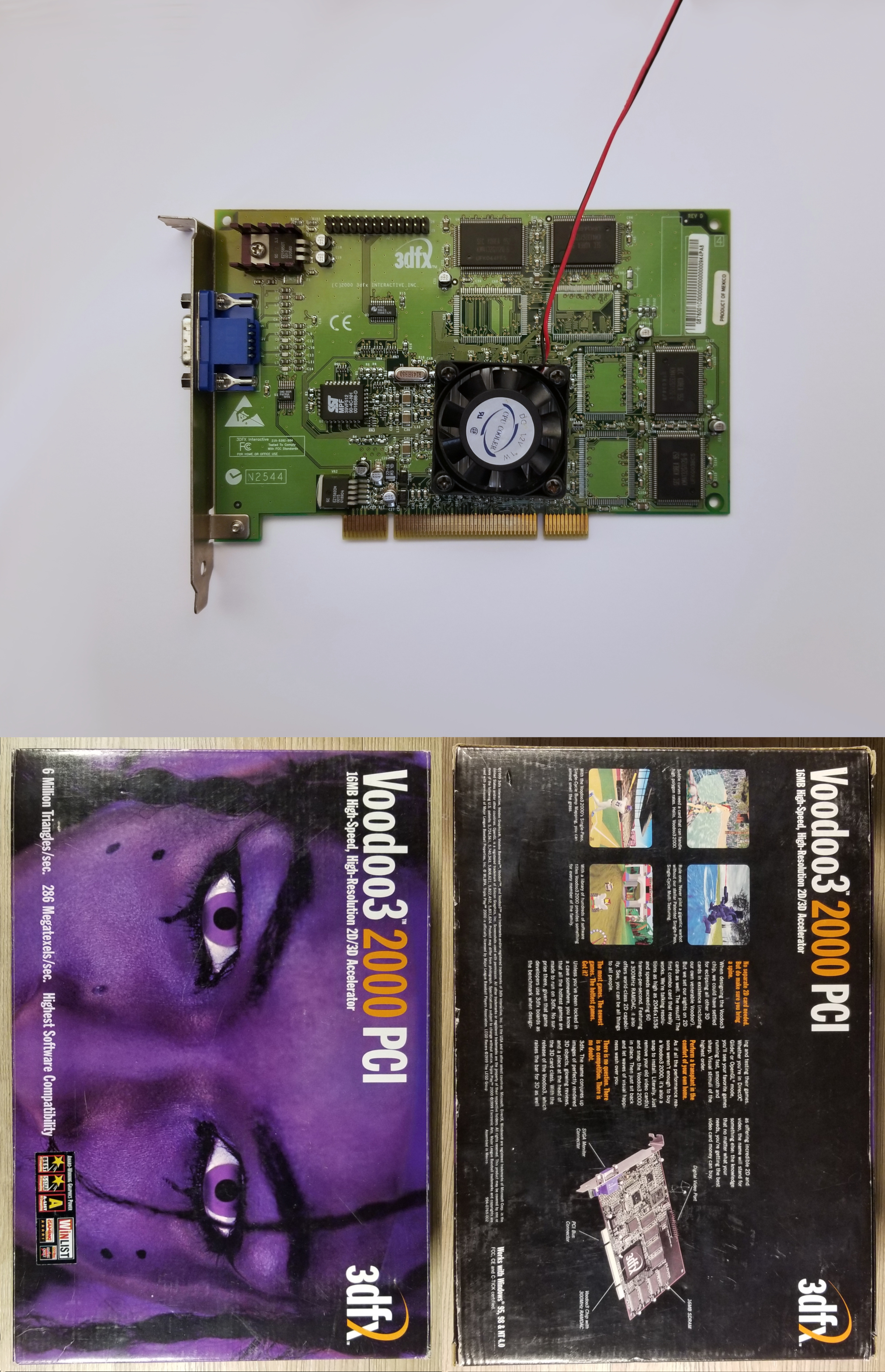
SoundBlaster AWE64 Gold (CT4390) with 28Mb RAM module - i know, grossly overpimped.
My excuse is that when searched for memory expansion module, the only one available on the Internets was this 28Mb model.
It was all or nothing situation. Went with the ALL option.
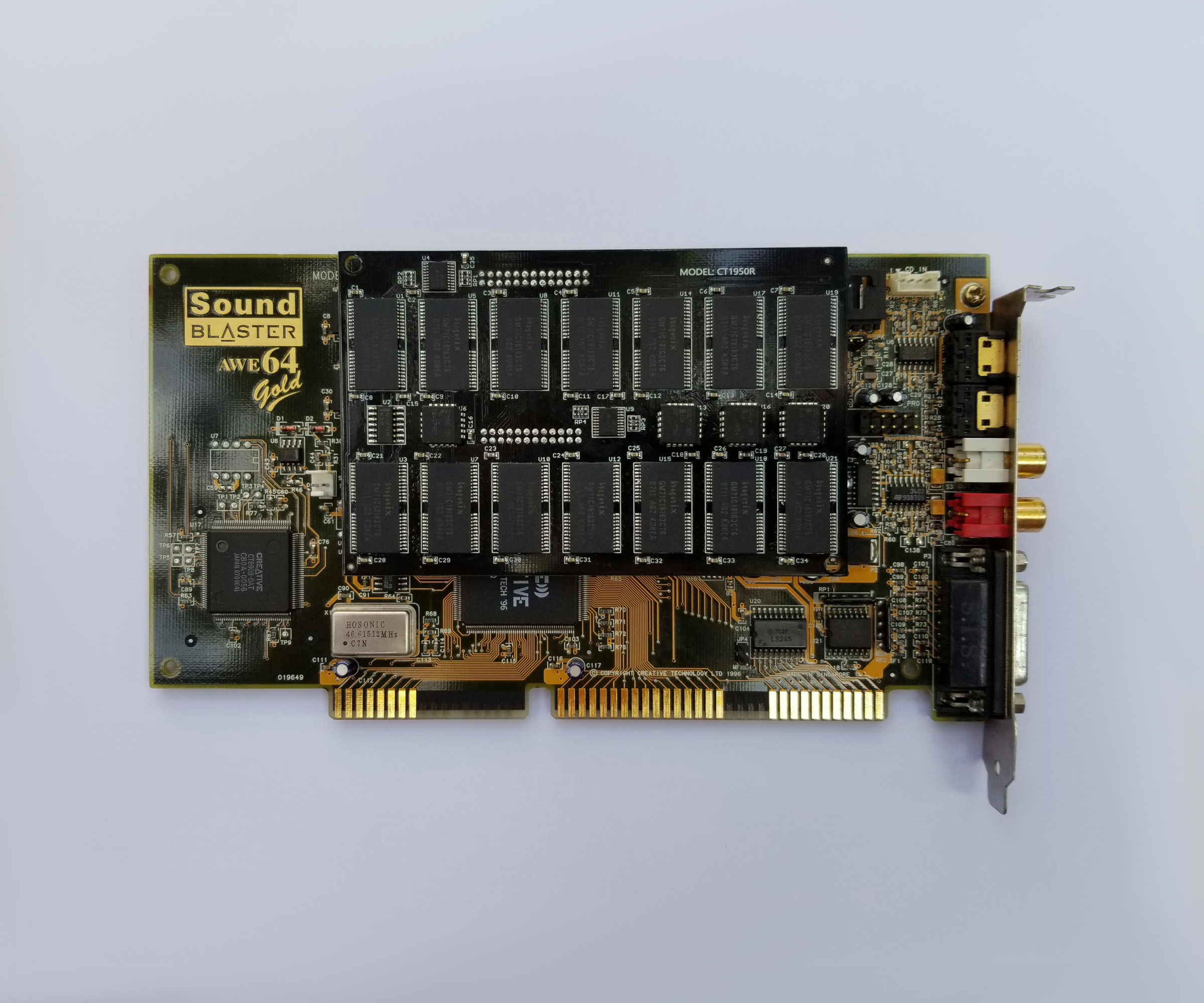
3COM Etherlink 10/100 XL 3C905-TX-M
Don't have picture of that - standard PCI card.
It force-tries to boot from network every time which is annoying.
Need to swap it with simpler 10/100 3COM model that does not do fancy.
Resolved by disabling this behavior with DOS util.
Once the system was moved to 200MHz (about that below) the 3COM ethernet adapter became unstable.
Story repeated with 1-2 other adapters.
Finally settled on a late TP-LINK card based on Realtek RTL8130D.
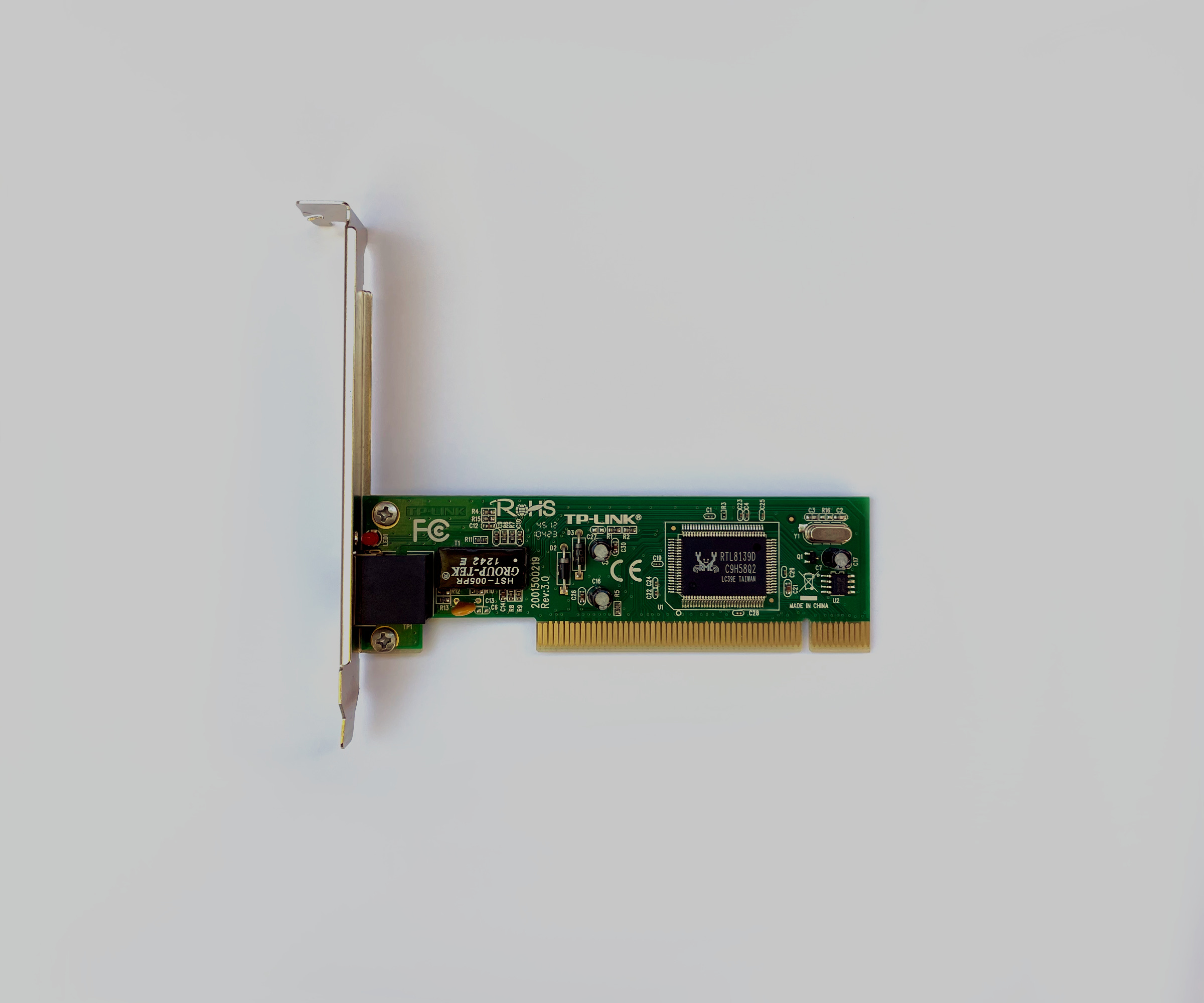
SanDisk Extreme 16Gb (1x500Mb FAT16, 2x2Gb FAT32) connected to the on-board IDE controller.
As mentioned before, Promise UltraATA-100 or 133 PCI controllers are unreliable on this motherboard when FSB is set to 60/66MHz, regardless if bus divider is applied or not.
Power supply is Athena 450W.
Fan is a bit loud, but less than 450W and the Peltier element is starting to overheat the power rails.
Compact 3D printed case.
PC assembly.
Decent cable management.
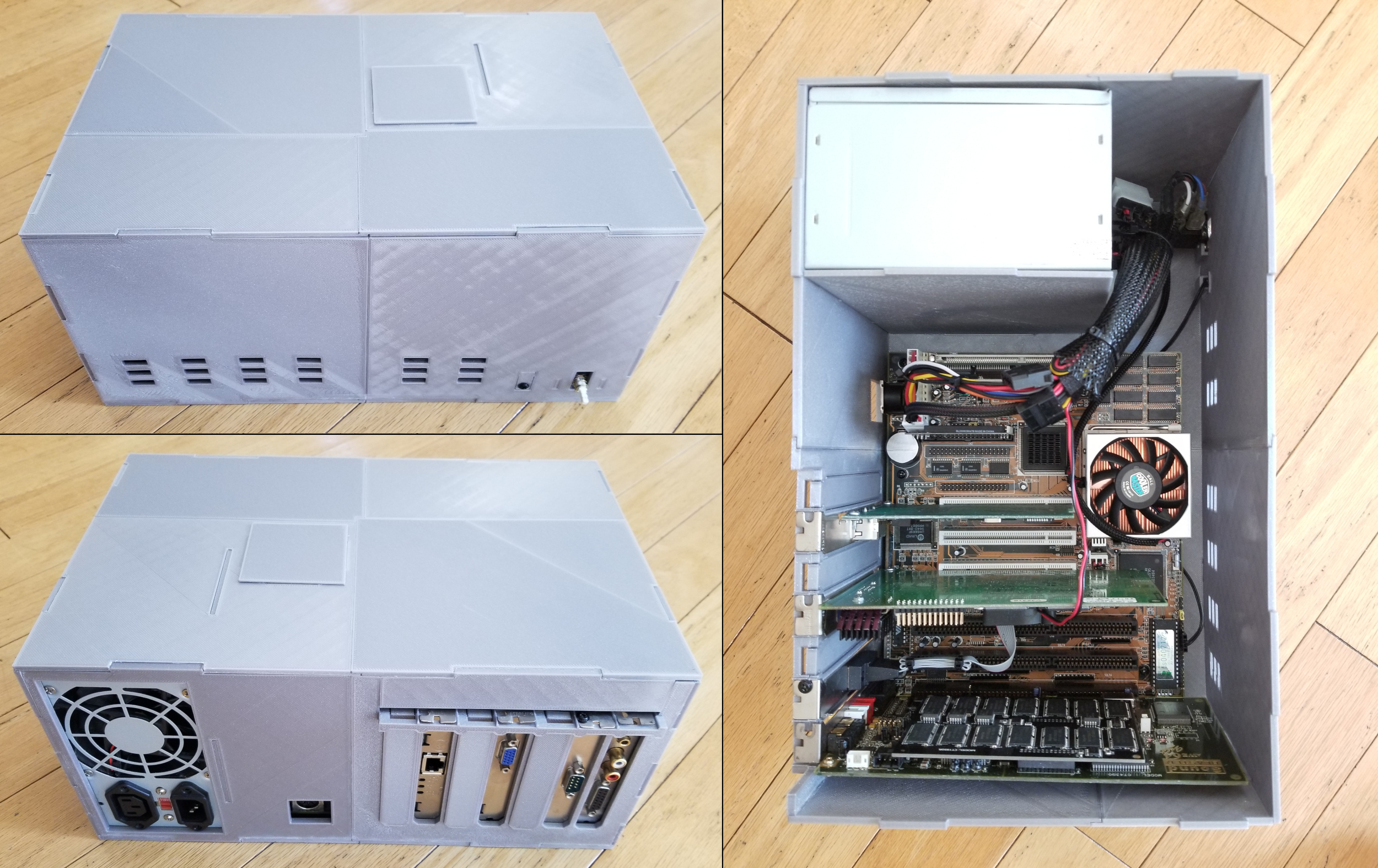
---
Had to get a bit scientific to solve the thermal equilibrium problem required for stable system without CPU water condensation.
It was not trivial. Will save you the details, but took me a moment to figure things out.
It gets rather hot inside the case - NetBurst style - very different environment compared to open air test bench.
Voodoo3's VRM is an oven. Added heatsink. Helps a bit.
SiS chipset is also surprisingly hot. Added heatsink. Helps a bit.
On-board VRM also got an extra heatsink.
Notice the power lines.
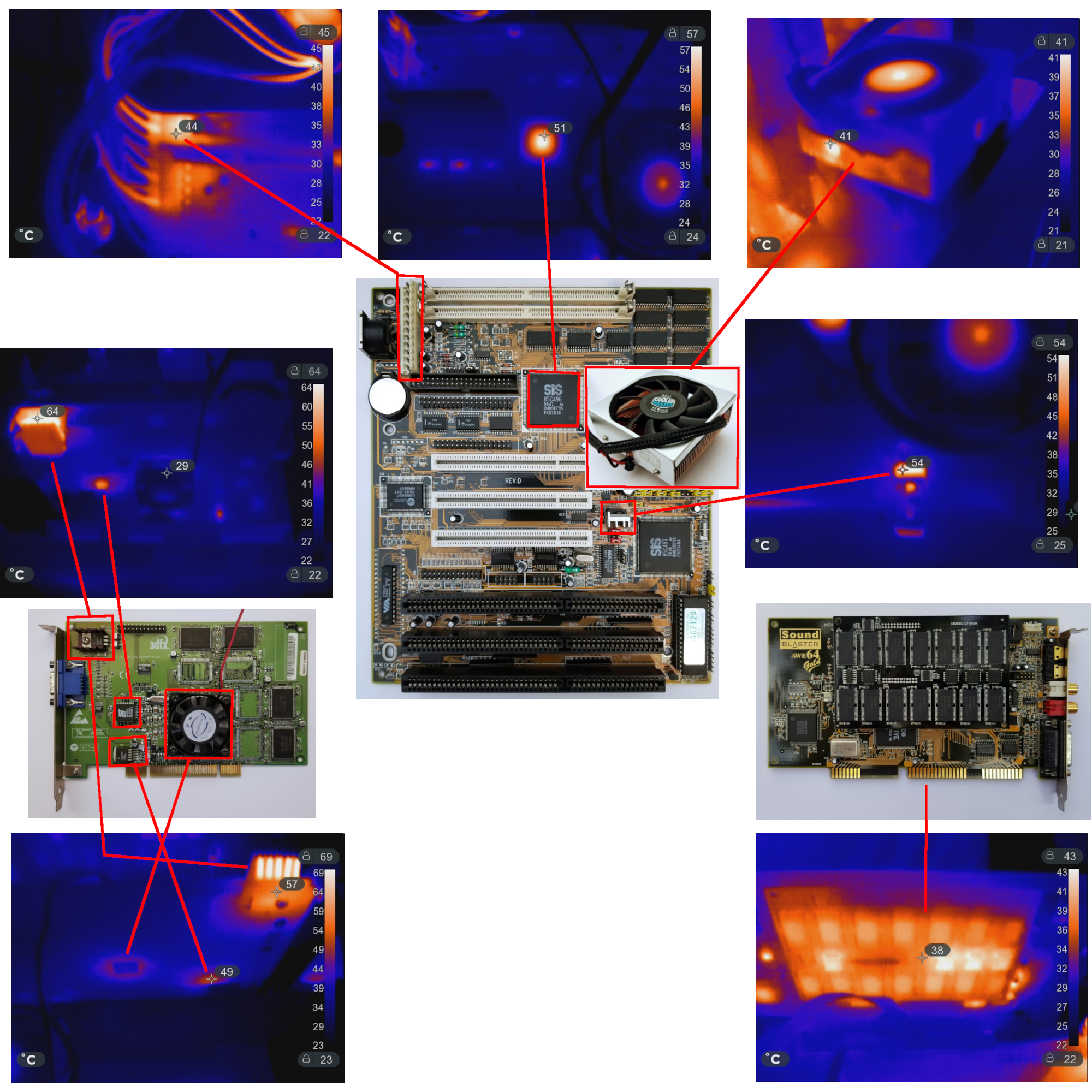
Considering the above, decided to add a fan opening - juust in case.
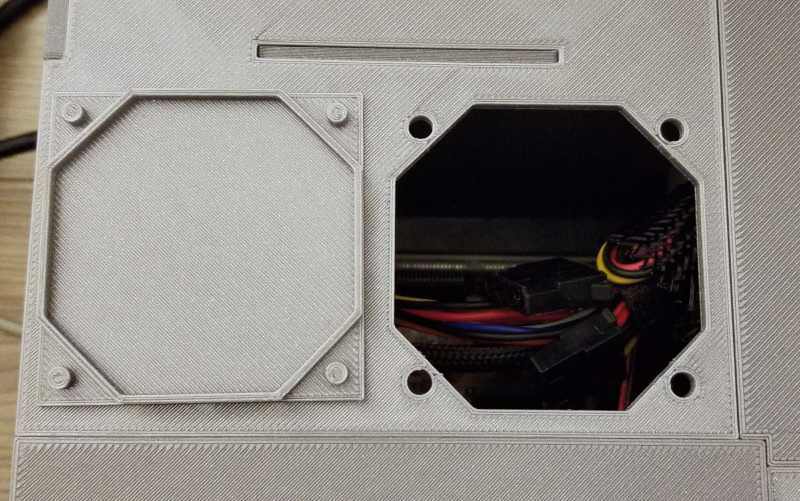
If the hardware composition of the rig changes, the CPU cooling unit will probably need adjustment too.
---
This is what SpeedSys says for the final PC configuration:
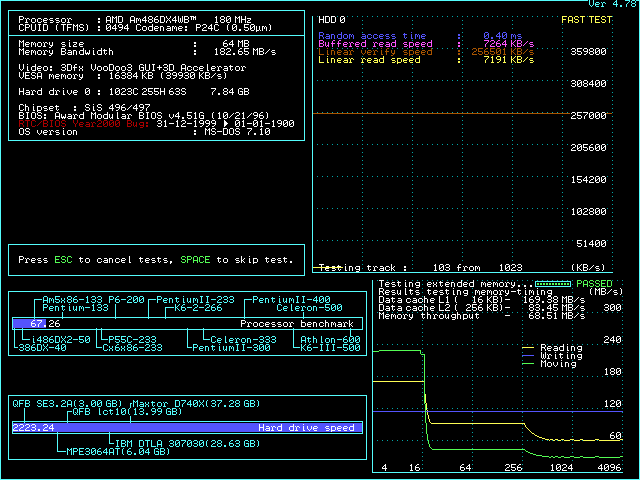
The LuckyStar LS-486E rev:D link above has all performance details of the system - won't repeat them again.
Voodoo3 matches Matrox MGA's VGA core in DOS interactive graphics, but does much better at Windows GDI.
Couple of numbers for brief reference:
Wolf3D: 148PCP Bench: 29.5Doom: 71.75 fpsQuake 1: 20.3 fpsGlQuake: 32.6 fps <- !!!WinTune2 (Windows GDI): 18201 <- !!!
Not bad, not bad.
Few words about ensuring long-term stability.
I start with interactive graphics in Phil's DOS benchmark suite.
They go quick and if some hardware cannot pass them gets discarded right away = time savings.
Don't bother with the simple DOS memory testing programs. They are time consuming, but also - very misleading.
Instead i move to Windows. Its environment is much more sensitive than DOS. There i run several tests like described below.
Basically - no half measures.
The rig is completely stable with all BIOS settings on max.
The beginning of this video shows heavy 3D rendering (for this computer), C++ project compilation and GLQuake, all running in parallel.
Actually the full test includes and copying of ~250Mb files too.
Let it grind for few hours.
It is brutal, but if everything survives - the rig is as stable as it can be.
Notice how long is the recovery to operational state despite staying within the 64Mb memory range and not going into swap.
The second part of the video shows standard stuff like speedsys, wintune, quake1, doom, as well and the hardware Inside the case.
---
To make sure i don't paint overly rosy picture, there is one issue with the LSD motherboard:
It does not like Gotek floppy emulators. Most of the time does not recognize them. The problem is not related to overclocking. It is present even at 25MHz FSB with most conservative BIOS timings. Cannot remember the last time when used floppy, so kind of unmoved about it.
---
Why i said at the beginning "probably the final chapter" instead of "the final chapter" ?
Will try Feipoa's 1024Kb L2 cache mod on the Biostar UUD board. It will be interesting if it can turn the table on LuckyStar D.
---
There was a community component to all this.
Thanks extended to BitWrangler, Feipoa, JakeThompson, MaxTheRabbit (A-Z order) for the insightful feedback and occasional cheerleading.
---
--- 200MHz
---
4 and a half years passed after the original post came to be.
The subject of 486 systems running at 180/200 MHz matured.
Additional details and facts emerged, knowledge solidified.
(a lot of it covered in following posts and in the "fastest 486" thread)
Running 180MHz today is almost trivial.
The new frontier is 200MHz on air cooling.
(for reference - probability of finding Am5x86 CPUs capable of 180/200MHz: here - second subject in the post)
Finally found the time to move the original 180MHz system outlined above to 200MHz.
200MHz can be achieved with 3x66MHz or 4x50MHz.
3x66 is faster in every test so using that option.
DOS and Windows 3.1 are completely stable with no bus divider but Windows 95 requires 1:1/2.
All BIOS settings on max except DRAM SPEED = FASTER.
If this parameter is set to FASTEST DOS and Windows 3.1 are pretty stable with this parameter set to FASTEST, but Windows 95 hangs.
No bus divider is possible as well.
Wolf3D and Doom benefit greatly from this configuration, but the system is not completely stable.
Needs further investigation. Leaving it for another time.
Here is what SpeedSys says - not bad, not bad:
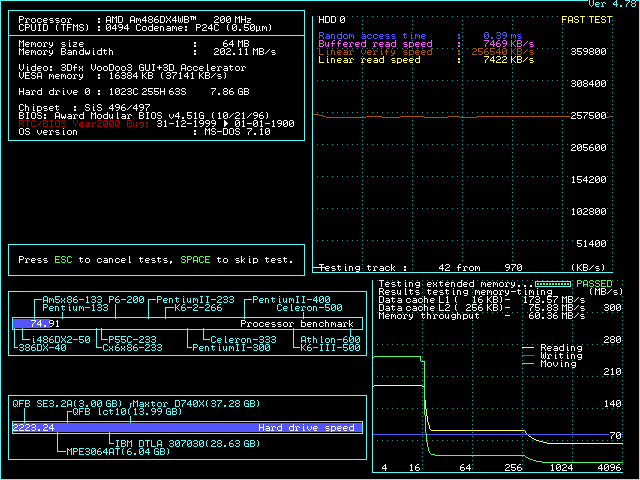
The usual tests.
First 3 lines are for the different configurations at 200MHz.
Line 4 shows the best numbers at 180MHz.
Gray bars indicate not fully stable system.
* - indicates 16Mb RAM only and fully maxed-out BIOS settings (DRAM SPEED = FASTEST). Fully stable in DOS and Windows 3.1 but not Windows 95 unfortunatelly.
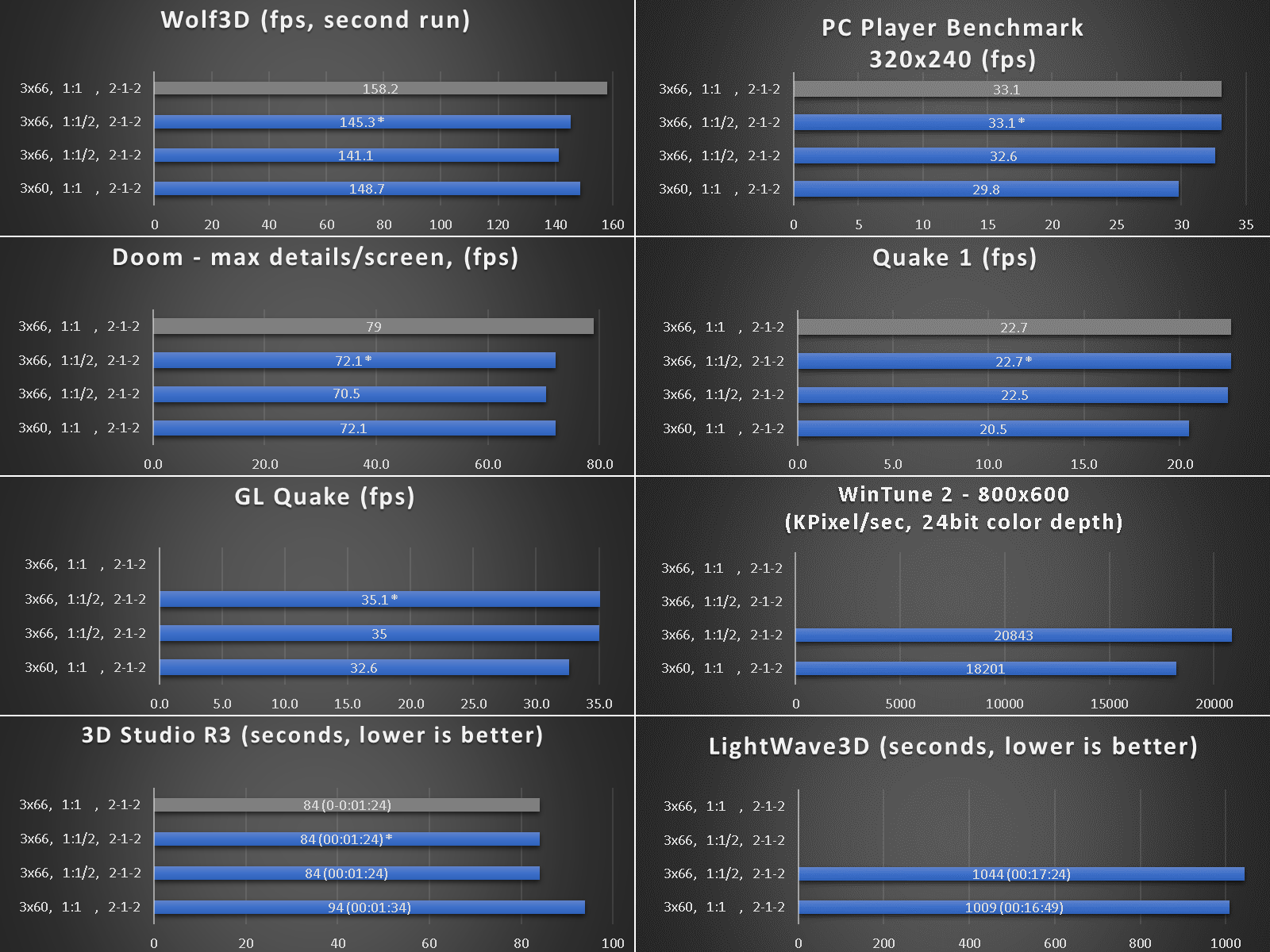
While most games/applications are CPU bound, the 1:1/2 bus divider required for complete system stability can lower framerates of games such as Wolf3D and Doom.
Quick run at 200MHz with Wolf3D, Doom, Quake 1, GL Quake, 3D Studio, LightWave3D, SpeedSys: video.
Two of the available CPUs here can handle reliably 200MHz at 4V + air cooling.
Initially used regular heatsink and fan but common sense prevailed and replaced them with the tried and working 5V Peltier contraption instead.
Decided to play safe after the loss of that 200MHz/4V capable ADZ chip several weeks ago while testing it on air cooling.
---
Couple of screenshots with the BIOS settings fully maxed-out (bus divider 1:1/2).
Can be achieved with one of those magical LGS 16Mb modules.
This is how we arrive at the highest Quake 1 score on 486 class CPU:
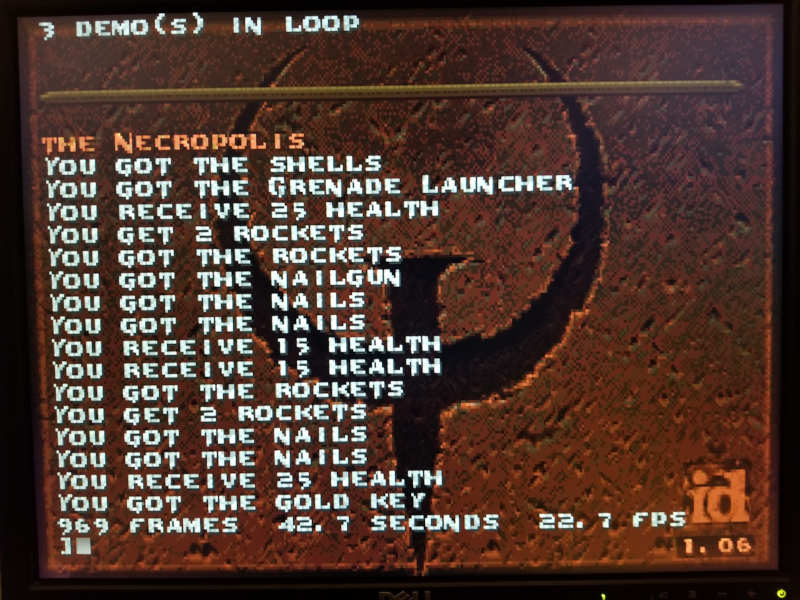
A video proof.
PC Player Benchmark is impressive too:
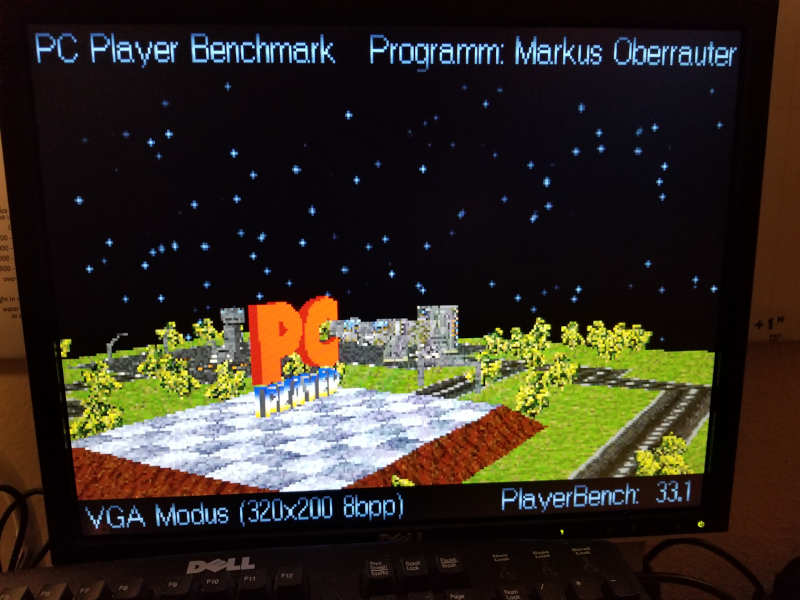
BIOS settings:
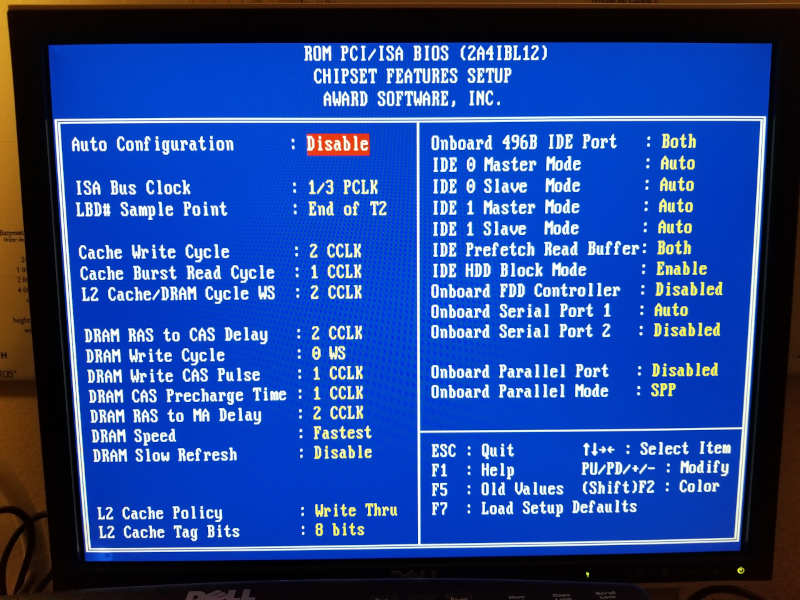
Speedsys:
Getting confused a bit in the local storage test. No idea why. CF card and IDE controller seems to be doing fine.
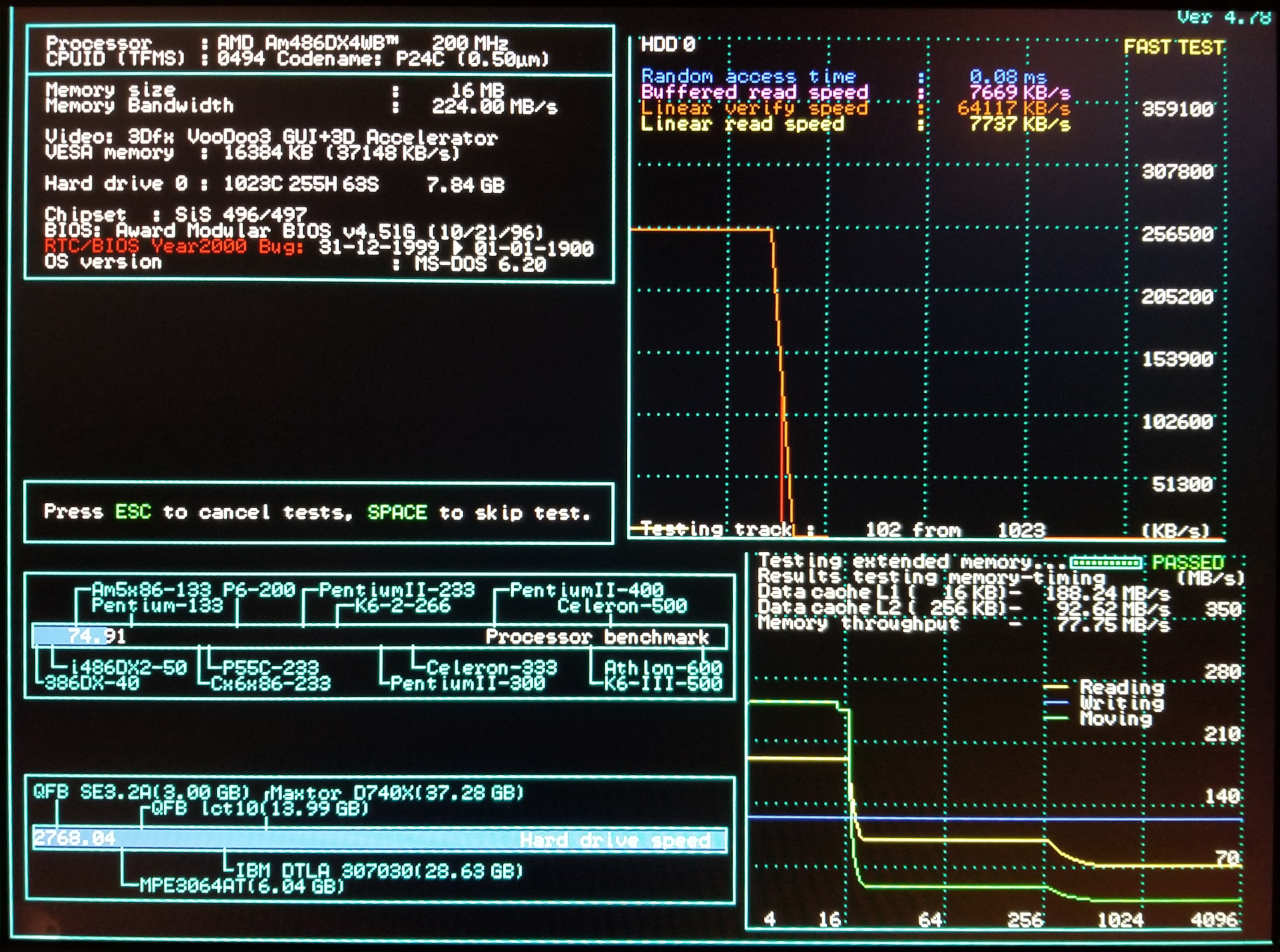
Not bad, not bad.
My first thoughts without edit:
Could you show a photo of how the black heatsink is attached to the peltier and how the peltier is attached to the CPU? You mentioned, "Used a plastic piece that wraps the CPU. Its "teeth" hold the heatsink", but I do not see it, nor can I imagine what this looks like.
Similarly, how is the copper heatsink attached to the peltier and the peltier to the CPU? Try running the same setup on the UUD. How hot is the power connector? If more in the normal range on the UUD, replace the AT connector on your LSD.
Are you able to run it with 60 ns memory to see if the 50 ns is necessary?
Is that one of those $165 Russian made AWE64 modules? I cannot beleive people are paying that much for these. I use the original SIMMConn modules, which I think serdashop are making now. I found that it takes too damn long to load a 28 MB sound bank. 8 MB is about the limit of my patience here.
Another thing that bugs me about the AWE64Gold, that is, aside from its many other shortcomings, is those RCA/composite style stereo jacks. I got so annoyed plugging in the 3.5" jack adapter everytime I brought out a case that I ultimately took a slot cover bracket and soldered on a female 3.5" jack.
Concerning your 3Com card - you should be able to load up the 3Com DOS config utilty to turn off that network boot feature.
Overheating the power rails thing - that is odd. I assume you mean on the connector junction on the MB. How much power does the peltier consume?
What is the cost of raw material to print that case, not including the cost of the printer?
I don't understand how your LSD's VRM is only at 54 C. Where does that 54 C come from? Is there a feature on your thermal gun to select a point and print the digital temperature? If so, perhaps move in closer and try a few different points, you might find it is closer to 61 C.
Quake 1 is 20.0 'eh? That's about the same as the IBM 5x86c-133/2x with 1024K on UUD (19.8 fps). Perhaps on the UUD it will go up to 20.0. Seems like I've tested that already but the result escapes me.
I didn't see a photo of the front of the case. Can you show a photo? Where's the buttons and LEDs, like power, reset, turbo, etc?
Plan your life wisely, you'll be dead before you know it.
feipoa wrote on 2021-09-11, 05:00:Could you show a photo of how the black heatsink is attached to the peltier and how the peltier is attached to the CPU? You mentioned, "Used a plastic piece that wraps the CPU. Its "teeth" hold the heatsink", but I do not see it, nor can I imagine what this looks like.
(the forum code auto-resizes the image - making it much smaller than it is - not sure why - hope it is good enough for you)
+ zip ties around the "teeth" for increased grip.
feipoa wrote on 2021-09-11, 05:00:Similarly, how is the copper heatsink attached to the peltier and the peltier to the CPU? Try running the same setup on the UUD. How hot is the power connector? If more in the normal range on the UUD, replace the AT connector on your LSD.
Between CPU and Peltier - small drops of Loctite glue in 2 opposite corners. Same for Peltier and heatsink.
Very sturdy and solid, yet easy enough to separate by applying the right amount of force.
I was concerned about this approach but turned out really well.
Also, Peltiers need good contact, so enough thermal paste needs to be applied. But the glued corners are clear from paste.
These Cooler Master coolers are badass.
Have two of them in a dual slot1 P3 rig.
Made sure this assembly fits both LSD and UUD - notice the trimmed corner.
feipoa wrote on 2021-09-11, 05:00:Are you able to run it with 60 ns memory to see if the 50 ns is necessary?
Yes, but memory wait states need to be increased.
50ns is a must for tightest DRAM timings.
feipoa wrote on 2021-09-11, 05:00:Is that one of those $165 Russian made AWE64 modules? I cannot beleive people are paying that much for these. I use the original SIMMConn modules, which I think serdashop are making now. I found that it takes too damn long to load a 28 MB sound bank. 8 MB is about the limit of my patience here.
Guilty on this one.
A while ago saw a post on the audio forum about impressive sounding Doom music based on some samples lib.
Got me interested and for some reason decided to mess around with the AWE64G, despite having 2 AWE32s with maxed ram. Don't ask why.
In a moment of weakness spent stupid $ on something that won't see a lot of action.
Still regretting it. 😖
feipoa wrote on 2021-09-11, 05:00:Another thing that bugs me about the AWE64Gold, that is, aside from its many other shortcomings, is those RCA/composite style stereo jacks. I got so annoyed plugging in the 3.5" jack adapter everytime I brought out a case that I ultimately took a slot cover bracket and soldered on a female 3.5" jack.
Yes, this can be annoying.
feipoa wrote on 2021-09-11, 05:00:Concerning your 3Com card - you should be able to load up the 3Com DOS config utilty to turn off that network boot feature.
Didn't know about that. Thanks for the tip. Do you have the util handy ?
feipoa wrote on 2021-09-11, 05:00:Overheating the power rails thing - that is odd. I assume you mean on the connector junction on the MB. How much power does the peltier consume?
Cannot remember right now how much was the power consumption. Had it written down somewhere, but it was a lot.
No Peltier - no PSU overloading.
Initially had 300W power supply and the wires were HOT.
feipoa wrote on 2021-09-11, 05:00:What is the cost of raw material to print that case, not including the cost of the printer?
$45 including shipping for 1Kg spool.
Good quality material.
If you don't do reprints 486 size PC case takes roughly one 1Kg.
This one is very compact and took 3/4ths. So around $35-40 in cost.
feipoa wrote on 2021-09-11, 05:00:I don't understand how your LSD's VRM is only at 54 C. Where does that 54 C come from? Is there a feature on your thermal gun to select a point and print the digital temperature? If so, perhaps move in closer and try a few different points, you might find it is closer to 61 C.
It is around 50-55C.
Confirmed by precise thermometer probe.
feipoa wrote on 2021-09-11, 05:00:Quake 1 is 20.0 'eh? That's about the same as the IBM 5x86c-133/2x with 1024K on UUD (19.8 fps). Perhaps on the UUD it will go up to 20.0. Seems like I've tested that already but the result escapes me.
It is 20 fps at 3-1-2 L2 cache timings for complete stability in Windows and some of those heavy tests.
Otherwise can use the system just fine at 2-1-2 for gaming and casual computing. In this case results is 20.4 fps.
UUD with tightest timings already does 20.1, but again, to pass the Windoes tests I mentioned it needs to go 2222 or even 3111.
Which brings it down to low to mid 19fps.
feipoa wrote on 2021-09-11, 05:00:I didn't see a photo of the front of the case. Can you show a photo? Where's the buttons and LEDs, like power, reset, turbo, etc?
Updated the picture. Hard refresh to get it.
That photo is horrifically small. It used to be that I'd edit my photos to be under 2 MB and Vogons would not autoscale my images, but now, even under 2 MB photos are being downscaled, though not to the level yours is. Where did those two plastic holders come from? I don't see the peltier in the photo.
Are you using the red or blue Loctite? What is the curing time? I've only used that stuff on car bolts.
Yeah, even the gold's built-in 4 MB can load some pretty neat sounding sound banks. But keep in mind that these banks need Windows 95 loaded to work! Welll, there are some hacks to use them in DOS but I haven't had very good luck with that.
Unfortunately, I cannot figure out how to open zipped *.exe files in Ubuntu, so I cannot see what is in my saved files for the 3com. Archive manager can't open the *.exe and I cannot figure out how to get p7zip to open the *.exe. How is everyone doing this? So... I'll just send you what file I have in my DOS drivers folder for the 3c905-tx-m. Crappy Linux.
Plan your life wisely, you'll be dead before you know it.
By the way, I decided to test the UMC IDE driver in master-mode flag (MM) with a Maxtor DiamondMax 10 and compare it to that of CF card on the UUD board. As you may recall, MM0 does nothing for single-sector transfers of CF cards, however it does wonders for my magnetic platter Maxtor drive.
CF card with UMC v3.1 /D0:16 /F0 /SM0
9,117 kb/s in Speedsys (buffered read)
Maxtor DiamondMax 10 with UMC v3.1 /D2:17 /F2 /MM2
18,946 kb/s in Speedsys (buffered read)
edit: when Maxtor is the primary boot drive, speed 17 would crash w95. So speed 16 max stable.
I put the Maxtor on the same speed as the CF card, that is /D2:16 /F2 /MM2, we get
14,406 kb/s in Speedsys (buffered read)
Another comparison is using the Maxtor in standard mode, that is, /D2:16 /F2 /SM2, we get
13,561 kb/s in Speedsys (buffered read)
Note that the "2" in MM2 refers to the IDE drive on the Secondary Master, even if there are just two HDDs in the system.
Plan your life wisely, you'll be dead before you know it.
Masterpiece.sf2 makes the 28MB totally worth it. Sounds amazing
I don't think I've tried that one. Does it work on the AWE64Gold/Value and is it free?
The largest soundfont I've tried is GeneralUser GS 1.35.sf2 at 26.6 MB, however I found 8MBGMSFX.SF2 at 7.6 MB to be a better trade-off for wait vs. sound. That should be on the Creative CD. I think there is a soundfont for purchase called Crystal something that is suppoesd to be pretty good one, but I don't have it.
Plan your life wisely, you'll be dead before you know it.
Thanks for the .exe
Worked well.
The numbers you posted are similar to what I see here.
I also noticed that 17/18 speed can be a problem.
The Awe64gold + RAM module was worth the investment at the end.
It is much more compact than awe32, otherwise the PC case had to be 2x its current size.
Yes, this sound font is great. Also, free of charge.
Where can Masterpiece.sf2 be procured?
How is everybody opening Winzip compressed *.exe files in Linux? It is darn irritating. WinRAR, 7Zip, etc. can just open them straight away in Windows. Do I need to go into XP and re-zip al lmy archive files using the *.zip or *.rar format? That will take a very long time. There must be some Ubuntu app which can open these *.exe archives?
Upon further testing, I noticed that the Maxtor could handle D0:17 /F0 /MM0 without corruption on the Secondary port, but not on the bootable drive. But to be safe, I put it down to speed 16.
Plan your life wisely, you'll be dead before you know it.
feipoa wrote on 2021-09-11, 22:04:I don't think I've tried that one. Does it work on the AWE64Gold/Value and is it free?
The largest soundfont I've tried is GeneralUser GS 1.35.sf2 at 26.6 MB, however I found 8MBGMSFX.SF2 at 7.6 MB to be a better trade-off for wait vs. sound. That should be on the Creative CD. I think there is a soundfont for purchase called Crystal something that is suppoesd to be pretty good one, but I don't have it.
Yes it works on AWE64, I just let the AWE control panel load it at windows startup so I don't ever just sit and wait for it. I turn on PC, go grab a coffee, then return later
feipoa wrote on 2021-09-11, 23:13:Where can Masterpiece.sf2 be procured?
How is everybody opening Winzip compressed *.exe files in Linux? It is darn irritating. WinRAR, 7Zip, etc. can just open them straight away in Windows. Do I need to go into XP and re-zip al lmy archive files using the *.zip or *.rar format? That will take a very long time. There must be some Ubuntu app which can open these *.exe archives?
Upon further testing, I noticed that the Maxtor could handle D0:17 /F0 /MM0 without corruption on the Secondary port, but not on the bootable drive. But to be safe, I put it down to speed 16.
If you are using the command line, 7z x file.exe should work, or perhaps cabextract file.exe or unzip file.exe. It all depends on what format the self extracting EXE is in.
If you are using the GUI, try file-roller aka engrampa.
I'll go start a UM8886AF/UM8886BF IDE thread since it seems interesting enough.
7za is the command-line option for p7zip. Normally to extract an archive you'd do:
7za x 3C905C-TX-M.exe
but it returns:
Can't open as archive: 1
The File Roller, now known as "Archive Manager for GNOME", was not working to unzip the exe. Gave some error. However, in the last few hours I had installed a variety of options using Synaptic and now the archive manager opens the *.exe. I think I installed p7zip-full (previously just had p7zip installed), unar, kate, konsole, krusader, and one more. Not sure exactly which one did it, but probably unar is the winner.
Edit: nope, not unar. I'm going through them one by one on another system.
Edit2: it is p7zip-full. Everybody should install that over just p7zip (not -full).
Plan your life wisely, you'll be dead before you know it.
Just looked at that file. It is an LHA archive, but not ZIP.
p7zip did it, but you already figured it out.
@jakethompson1
Open the season please.
It may be better to star the thread in this forum.
It is more quiet than the general one.